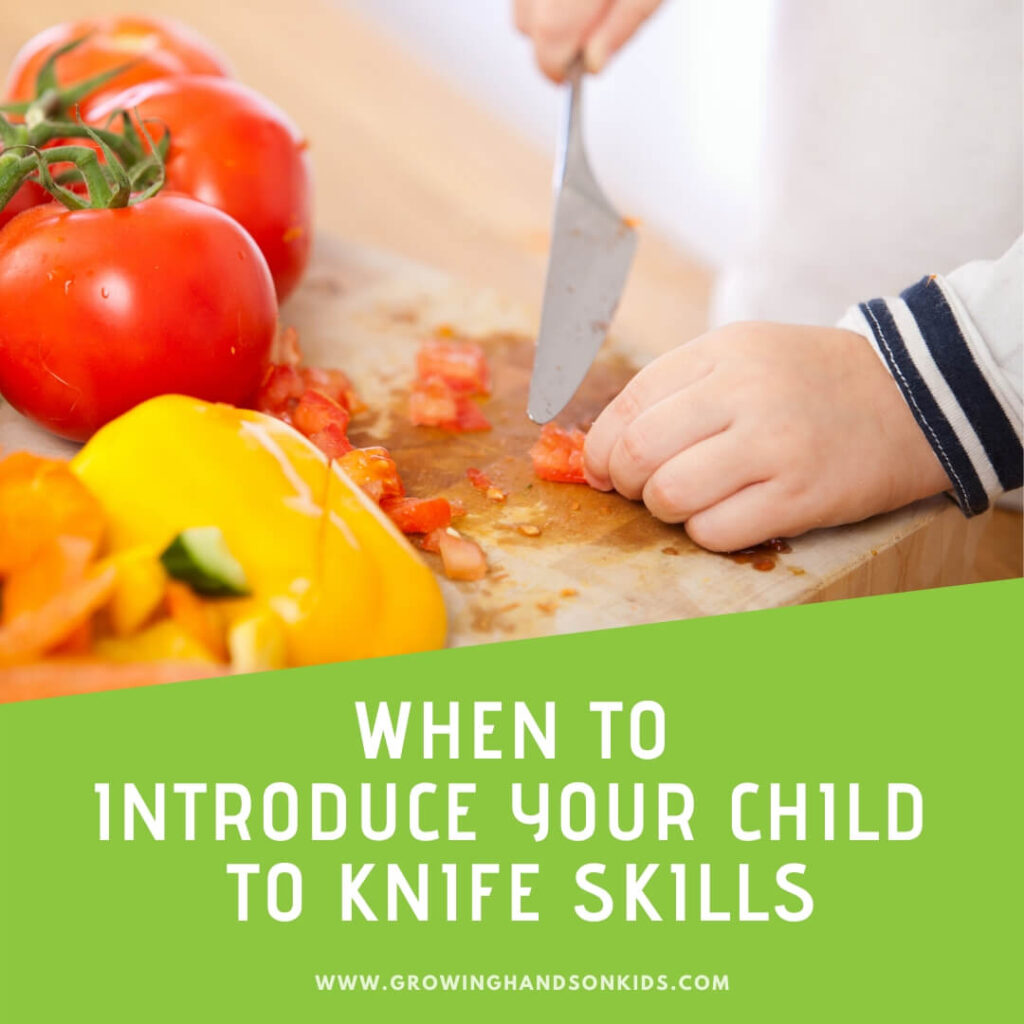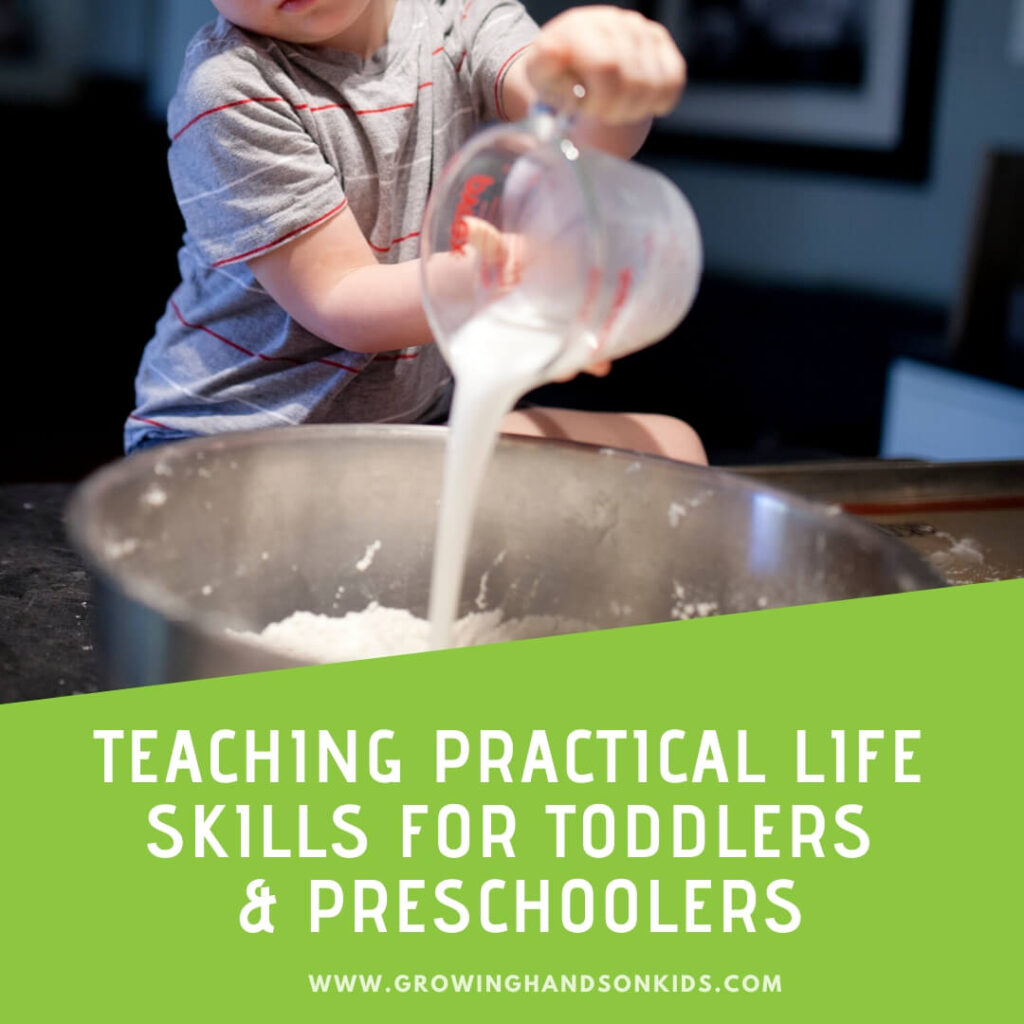When to Introduce Your Child to Knife Skills
Affiliate and Referral links are used below to promote products I love and recommend. I receive a commission on any purchases made through these links. Please see my disclosure policy for more details. As an Amazon Associate, I earn from qualifying purchases.
Over the weekend I shared a picture on Instagram of my two children helping me in the kitchen by cutting peppers and cucumbers with paring knives. The reason for the post was to share that the best fine motor activities are always practical life or everyday life activities. It didn't cross my mind that people would wonder and ask when to introduce a child to knife skills.
Today I want to share some tips and suggestions for when to introduce your child to knife skills from a developmental standpoint along with the best ways to practice.
When To Introduce a Knife to Your Child
Children typically become interested in using flatware when they start to eat solids. You may notice your baby always grabbing for the spoon when you try to feed them.
Many children start solids around 6 months of age. But they don't start relying on solids as their main source of food until 12 months or older.
Most children are able to start feeding themselves by 2 years old, either with finger foods or with a spoon. They can also begin stabbing items with a fork.
Knife skills require bilateral coordination, something your baby or young child is working on all the time as they learn to walk and complete other gross motor or fine motor skills.
Introducing a knife can begin as young as two years old, but every child is different.
Most children will master how to spread with a knife by 5 years old, and using a knife and fork together to cut their food around 7 years old. But as with all skills, it takes a lot of practice that can begin at a much younger age.
Resource: Using a Knife & Fork Information Sheet from NHS.
How to Introduce Using a Knife to Your Child
I really appreciate how the Montessori method introduces children to using a knife and promoting independence in feeding, even at a young age. Using this method, I introduced my daughter to a knife around 2 years old.
Montessori and Occupational Therapy really work well together, particularly with everyday life skills or practical life (as it is called in the Montessori Method).
Let's take a look at how you can safely introduce your toddler or younger children to using a knife.
When I started introducing my daughter to using a knife, we began with a wavy chopper knife, which I found on Amazon. This type of knife is perfect for toddlers because it uses a whole hand grasp that they are already using with many other fine motor skills.
A quick note about knives for under age 2: Before introducing the wavy cutter, you can use a regular butter knife or small spreader to introduce using a knife with your young toddler. I use the small child flatware set from IKEA which comes with a knife, spoon, and fork. These are the perfect size for small hands and would also cut through soft foods.
When introducing any knife to your child, you should begin by introducing knife safety rules.
- Knives are a tool, not a toy (our knives are out of reach and behind magnet safety locks in the cabinet so they only come out when used for cooking and when I am right beside them)
- Always point the end of the knife away from yourself and others
- Never cut with the knife pointed towards you
- Always look around you before you begin cutting to avoid someone or other objects around you
After talking about the rules for knife safety, begin by showing them how to hold the knife safely.
With all introductions, you can begin by demonstrating yourself, then using hand-over-hand with your child. Then when they are ready, allow them to try independently.
Always start with soft objects for them to cut such a banana or soft piece of fruit. This requires less pushing effort on their part and has a greater chance of success for them. Avocados, berries, or any other type of softer fruits or foods are a great practice with the wavy cutter.
I do show them how to hold the piece of fruit with the other hand as they cut. Just remember that this is a skill that will develop over time. Using both hands together for an activity requires bilateral coordination and integration, so it will take a lot of practice before they master this. If they are only able to cut with using both hands on the wavy cutter at first, that is totally okay!
Also, try not to interfere with what size of food your child cuts. It's about the experience and practice, not the way the food pieces look or what size they are. Believe me, I know how hard it is to try and sit on your hands and just let them explore. But it is the best approach.
After your child has mastered using a wavy cutting tool, you can start introducing a plastic cerated knife or a nylon kitchen knife. These knives are sharp enough to cut food items, but won't hurt the skin as much as a regular knife.
After using nylon knives, around age 5 or 6 I started having my daughter use a small paring knife. They are sharp enough to cut fruit and vegetables, but not super sharp. My son, who is 5, also just started using a parting knife, as seen in this picture below.
Before introducing a new tool, it's important to make sure your child has mastered using the previous tool and that they are able to follow any new safely rules with the new, sharper tool.
As with all skills, practice makes progress. The more experiences you can give to your child in the kitchen, the better their knife skills will become.
If you a curious on how to formally introduce a knife using the Montessori Method, here are some resources:
- How to Introduce a Knife to a Toddler from Montessori Method
- Montessori and Knives from How We Montessori
- Our Progression of Knives from Age 1 to 3 from The Kavanaugh Report
- Cutting with a Knife from Living Montessori Now
There are also some great activities to practice knife skills outside of the kitchen.
Some of my favorites include:
- Cutting play dough with play dough tools
- Cutting food toys

Heather Greutman, COTA
Heather Greutman is a Certified Occupational Therapy Assistant with experience in school-based OT services for preschool through high school. She uses her background to share child development tips, tools, and strategies for parents, educators, and therapists. She is the author of many ebooks including The Basics of Fine Motor Skills, and Basics of Pre-Writing Skills, and co-author of Sensory Processing Explained: A Handbook for Parents and Educators.




